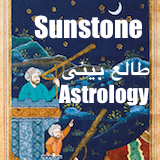By Calvin Tomkins
The New Yorker
For the first eight years of her life as an artist, Tala Madani, who was born in Tehran, painted only men, and not to their credit. “Caked,” in 2005, shows a brawny, nearly featureless oaf in a black undershirt smashing a cake in another oaf’s face. Next came a series of small paintings of men with plants growing out of their crotch—one of them tends to his foliage with a watering can. In 2011, she painted several men whose testicles hung from their chin, and a man in spirited conversation with his vital organs, which have been removed and placed in a comfortable chair. A series of 2015 paintings present men whose colossal, fire-hose penises take on lives of their own. None of these images suggest animosity toward the male species. The harmless dopes in Madani’s early work gave way to middle-aged, potbellied, bearded losers, whose weird plights make us laugh. Madani is that rarity in art, a wildly imaginative innovator with a gift for caricature and visual satire, and her first great subject was the absurdity of machismo. “I do think machismo is healthy and alive everywhere, and I was having fun upending it,” she told me last summer, when we began a number of conversations. “You know, you want it to grow bigger, so why not water it?”
Madani, who turned forty-one in December, left Iran with her mother and moved to this country in 1994, when she was twelve, and she now lives with her husband and their two children in Los Angeles, where her first major museum show in the United States is on view (until February 19th), at the Museum of Contemporary Art. I went through the show with her in October, enjoying her candid, funny, and often self-deprecating comments on individual works and on the exhibition itself. “I wanted all these images, but I kept wondering whether the works would look better if there were fewer of them,” she said. “It’s supposed to be this great event, to show your work, but what does that mean? Looking is the thing, not showing.” Her doubts had largely subsided by the time I arrived, and her high-spirited, ebullient personality was in full flower. She radiated energy—talking rapidly, laughing often, and using both hands to rake back her abundant, shoulder-length dark hair. I asked her about the show’s title, “Biscuits,” which appears, in her cursive handwriting, on the catalogue’s cover and on the wall at the entrance to the exhibition. “My kids were around one day when we were installing, and they were saying ‘biscuits’ over and over,” she said. (Her daughter, Imra, is seven; Imra’s brother, Roshan, is four.) “The show’s title is non-threatening in the way I want the paintings to be, and, you know—it’s biscuits, everything is O.K. I’m really happy with it.”
Madani is acutely aware that her exhibition coincides with the political crisis in Iran, which erupted in September when a twenty-two-year-old woman named Mahsa Amini died in police custody after being arrested for wearing her head scarf improperly. Madani’s feelings for the country of her birth are heartfelt and complex. “The disappointment and pain that I feel for the failures of the Iran government to simply do what is needed to serve the population of Iran is too deep,” she told me. She follows the situation in Iran closely via the Internet, news outlets, Telegram, and the comments of Iranians on the street who are calling for change. She also posts information every day on her own Instagram account, which has more than twenty-one thousand followers. Privately, she longs to connect more directly with the people there.
The two curators who installed “Biscuits,” Rebecca Lowery, an associate curator at moca, and Ali Subotnick, an independent curator who has seen Madani’s career develop from the outset, both told me that Madani had been a fiercely active collaborator. “She was very hands-on,” Lowery said. “Maybe a little more so than other artists. We had disagreements at times, which were healthy and productive and sometimes frustrating.” “Everything was a negotiation,” Subotnick recalled. “She’s tenacious, persistent, and so, so curious.” The exhibition opens with “The New Landscape,” a fifteen-foot-wide image of a nude male figure lying face down, with his legs splayed out on both sides. The man’s testicles are where they’re supposed to be, and are clearly visible to us and to the five much smaller people whom Madani has placed in the foreground, holding up offerings as though to a deity. In spite of the testicles, she said, some viewers read the image as feminine—maybe because of all the Mother Nature references in art—and this makes her wonder if she should do it over. Madani often repaints an image, with changes. The first version of this painting, in 2017, was several feet wider. Its owner did not respond to moca’s requests to borrow it, so Madani painted another, which she made slightly smaller, to fit the space.
There are a hundred and thirty-six works in the show. Some are small, less than two feet square; these tend to be lushly painted, with thick impasto and bravura brushwork. The larger ones are more thinly painted, and more abstract. Since 2007, Madani has made brief, stop-motion animations, and many of them are also on view, a few on monitors in galleries of paintings and the rest in a room of their own. The exhibition is not hung chronologically—a wise decision, because Madani’s work is not sequential. What interests her, she told an interviewer, is “art that excavates from the psyche, not the frontal lobe, not the intellectual, not the speakable, but the unspeakable.” I was reminded of this comment in a gallery where several of her “Pussy” paintings were on view. “Abstract Pussy” (2013) shows a prepubescent girl in a striped skirt, sitting on the ground with her knees pulled up and her legs apart, and four minuscule, presumably male figures who have crawled in for a closer look at her exposed vagina. (She is not wearing underpants.) Why is this image funny? I’m not sure, but it is. The girl is guileless, and the tiny men are clueless—for them, this appears to be an educational experience, not a sexual one >>>










Comments